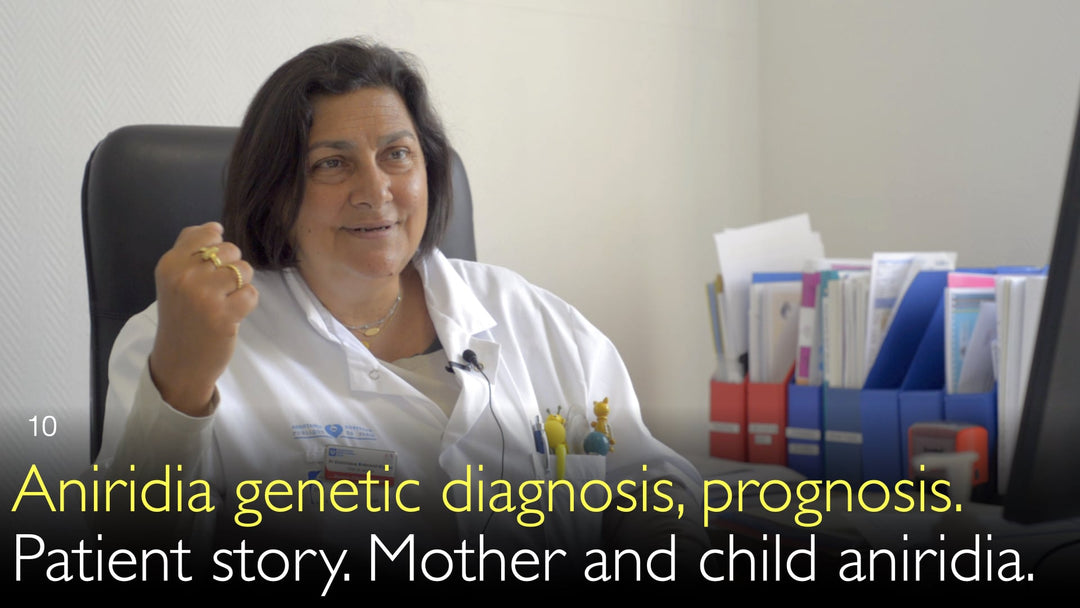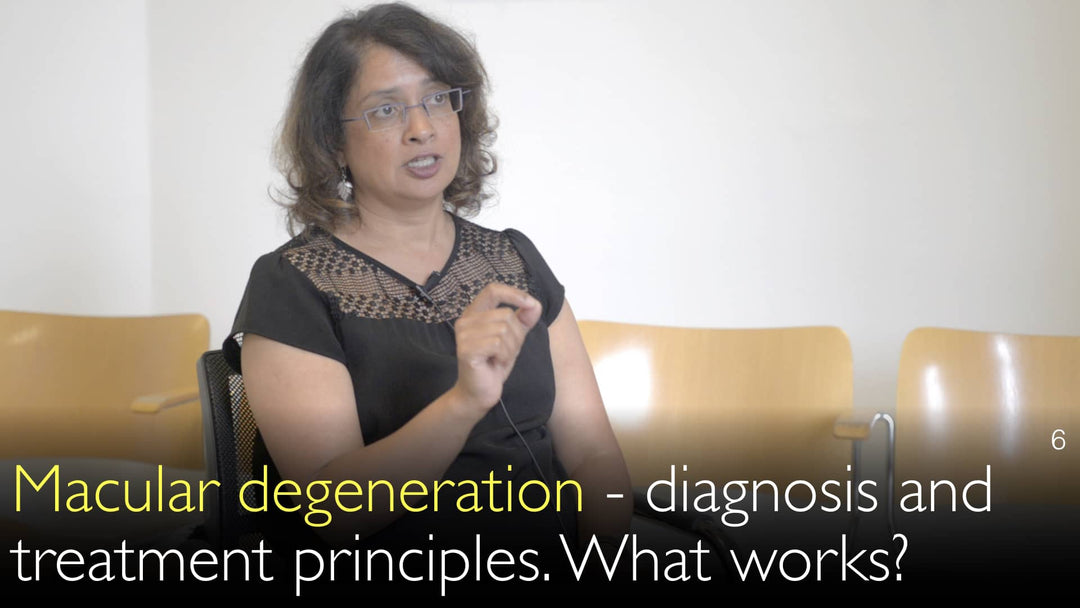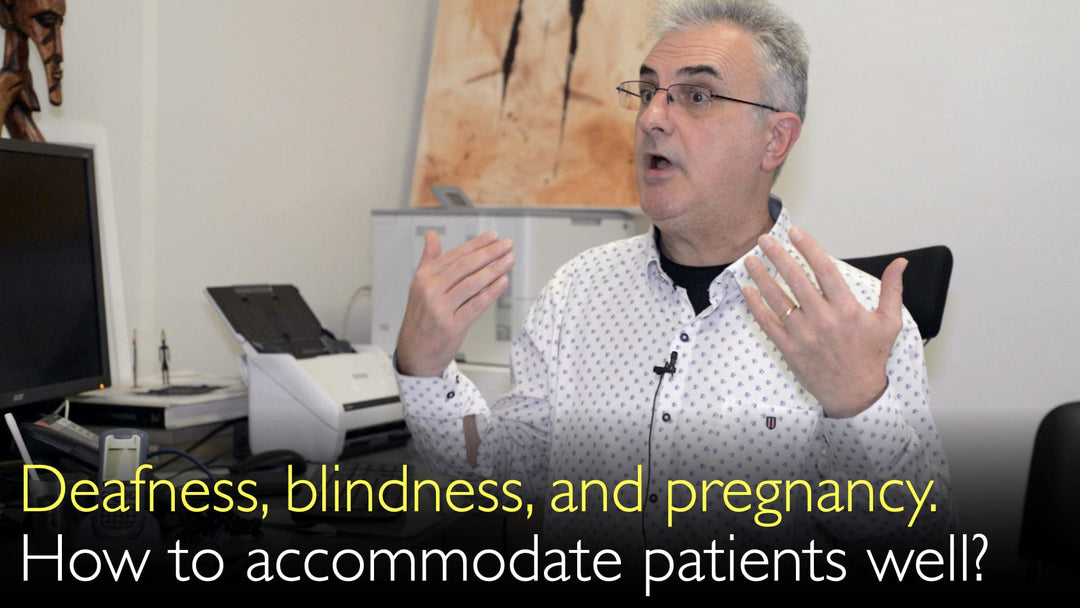Leading expert in congenital aniridia, Dr. Dominique Bremond-Gignac, MD, explains how this rare panocular disease is caused by PAX6 gene mutations and details the latest research into treatments like ataluren eyedrops. She emphasizes the critical importance of early genetic diagnosis and phenotyping to prevent severe vision complications and enable informed family planning decisions, sharing a powerful patient story that underscores the life-altering consequences of a missed diagnosis.
Congenital Aniridia Diagnosis, Treatment, and Genetic Counseling
Jump To Section
- What is Congenital Aniridia?
- PAX6 Gene Mutation Research
- Ataluren Therapy for Aniridia
- Phenotyping and Genotyping Importance
- Aniridia Patient Story
- Genetic Testing and Family Planning
- Referral to Specialized Centers
- Full Transcript
What is Congenital Aniridia?
Congenital aniridia is a rare developmental eye disease often mistakenly thought to involve only the absence of the iris. As Dr. Dominique Bremond-Gignac, MD, clarifies, it is in fact a panocular disease, meaning it affects the entire eye. This condition serves as an important model for understanding a wider range of eye diseases due to its complex nature.
PAX6 Gene Mutation Research
Extensive research into congenital aniridia has identified mutations in the PAX6 gene as the primary cause. Dr. Dominique Bremond-Gignac, MD, leads significant European research programs focused on this condition. The core of the research involves finding ways to recover the function of the PAX6 protein, which is crucial for normal eye development.
Ataluren Therapy for Aniridia
A promising therapeutic approach for aniridia involves the medication ataluren. Dr. Dominique Bremond-Gignac, MD, explains that ataluren acts as a form of gene therapy by enabling a "jump over" stop codons caused by nonsense mutations. This action can potentially recover the production of the functional PAX6 protein. An initial clinical study using oral ataluren showed positive trends, though results were insufficient for drug approval.
Research is now advancing on formulating ataluren as eyedrops. Dr. Dominique Bremond-Gignac, MD, highlights that this localized delivery method could be particularly beneficial for treating corneal opacity, a common and vision-impairing complication in aniridia patients, by restoring corneal transparency.
Phenotyping and Genotyping Importance
A critical step in managing aniridia is thorough phenotyping—the detailed description of disease signs—coupled with genotyping. Dr. Bremond-Gignac's work with a cohort of approximately 350 aniridia patients demonstrates that matching a patient's specific phenotype with their genotype is key to personalizing treatment and improving prognosis.
This approach helps prevent complications, as patients can present with dominant issues in the cornea, glaucoma, or macular hypoplasia. As Dr. Anton Titov, MD, discussed with Dr. Dominique Bremond-Gignac, MD, a precise diagnosis dictates the correct treatment pathway on an individual basis.
Aniridia Patient Story
Dr. Dominique Bremond-Gignac, MD, shared a poignant story illustrating the consequences of underdiagnosis. A 35-year-old female patient had lived with a coloboma in one iris and low vision, yet never received a definitive aniridia diagnosis or genetic testing. After getting married and having a child, her baby was born with complete congenital aniridia caused by a PAX6 mutation, which the mother also unknowingly carried.
This case, as Dr. Bremond-Gignac stresses, shows how a partial aniridia presentation can be difficult to diagnose without specialist input. The patient was tragically unaware of her high risk of passing on a severe form of the disease to her offspring.
Genetic Testing and Family Planning
Early genetic diagnosis of aniridia opens crucial family planning options. Dr. Dominique Bremond-Gignac, MD, explains that once a PAX6 mutation is identified, prospective parents can consider preimplantation genetic diagnosis (PGD) to select an embryo without the mutation before pregnancy. In some cases, parents may also consider pregnancy interruption based on a genetic diagnosis.
As Dr. Anton Titov, MD, noted, these are profound decisions. Dr. Dominique Bremond-Gignac, MD, confirms that the power to make an informed choice is entirely dependent on receiving a timely and accurate diagnosis, which was absent in the patient story she shared.
Referral to Specialized Centers
Due to the diagnostic challenges of conditions like partial aniridia, Dr. Bremond-Gignac strongly advocates for referring patients with anterior segment dysgenesis to specialized eye centers. Experts at these centers can perform advanced diagnostic explorations, establish a correct diagnosis, and facilitate appropriate genetic counseling and long-term management in collaboration with a patient's general practitioner.
This ensures that patients fully understand their condition, its hereditary risks, and the management strategies needed to protect their vision and inform their life choices.
Full Transcript
Dr. Anton Titov, MD: What is aniridia? What are the treatment options for aniridia? And what is the latest research on aniridia of the eye?
Dr. Dominique Bremond-Gignac, MD: Congenital aniridia is a rare disease. But contrary to the term, when you say aniridia, you say, "Okay, there is no iris." But aniridia is a panocular disease. It affects the entire eye. It is a developmental disease.
Aniridia is a very interesting disease because it can be a model to understand many other eye diseases. We have done a lot of research on aniridia. We have a European program that has been accepted.
Research on aniridia shows the mutation of the PAX6 gene to recover the PAX6 protein. There was a first clinical study of aniridia therapy with ataluren. Ataluren is a type of gene therapy because it creates a jump over stop codons, so ataluren recovers nonsense mutations. You can recover the PAX6 protein.
A clinical study showed positive trends after oral therapy with ataluren, but it was not enough for approval. We also developed ataluren as eyedrops. We think that for the cornea, it could be very interesting to recover transparency. Recovering the PAX6 protein is possible.
Phenotyping of aniridia is very important. We have around 350 aniridia patients. If you get a good phenotype—disease sign descriptions—and if you have done the genotyping, you can go further to prevent more problems.
Some aniridia patients have more problems in the cornea, others with glaucoma, and others with macular hyperplasia, which can be more important but sometimes mild. A good phenotype with a good genotype could match patients with the right therapy. It would make a better prognosis and prevent complications.
That is very important for the recognition of aniridia. It determines the correct way of treatment and diagnosis. As you mentioned, it depends on the phenotype. It depends on the correct description of symptoms and doing the right diagnostic tests to see what's going on with that particular patient on an individual basis.
Dr. Anton Titov, MD: This is a very good question. Of course, I have a patient story, and it is very short. It's about congenital aniridia.
Dr. Dominique Bremond-Gignac, MD: It is an underrecognized eye disease. I had a patient with aniridia. She was a woman of 35 years of age. She had in only one eye a coloboma of the iris. She said, "They said that it was like this, and so it was okay. I have very low vision, but nobody asked me for special diagnostic tests. Okay, all right."
She was just married and had a child. The child had complete congenital aniridia. It was a PAX6 mutation in both the child and this patient. In this patient, the PAX6 mutation-related disease was not recognized. She was not aware of having a risk of having a child with complete congenital aniridia and severe problems.
This patient was not aware of the risks. It is important to make the diagnosis. Sometimes partial aniridia is difficult to diagnose today. That's why anterior segment dysgenesis must be referred to specialized eye centers because experts can go further with diagnostic exploration.
Then experts can have a discussion and follow up with the general practitioner. But I think this is very important to establish the correct diagnosis because the patient must be aware of risks and understand they can have a child with severe disease.
Dr. Anton Titov, MD: If the aniridia disease was recognized in this 35-year-old woman earlier, is there anything that could have been done to prevent the disease in her child? Is it a matter of genetic testing and potential selection of embryos who do not carry the mutation? Is there anything else that could influence the outcome?
Dr. Dominique Bremond-Gignac, MD: Of course, if you recognize the aniridia disease early in the patient and when she is pregnant, we have both possibilities. We can select before pregnancy to choose the embryo without the PAX6 aniridia mutation. That could be a very good option.
I have some aniridia patients that did that. Also, we can see pregnancy interruption if the parents would like that. This is an option that could be very useful for parents with aniridia. But parents must know the possibilities, so they accept or don't accept options. That's why timely diagnosis is important.
Dr. Anton Titov, MD: Right. So the decision could be more informed by knowing the diagnosis. And that was a very important clinical story. It is an example of getting the right diagnosis at the right time.
Dr. Dominique Bremond-Gignac, MD: Exactly.







